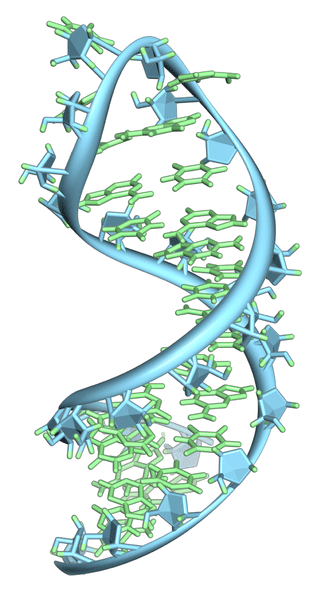Small Matters: RNA
Air Date: Week of March 7, 2014

RNA (Wikipedia)
Life originated from substances that somehow managed to progress from chemical reactions to self-replication. Exactly how that happened, and what exactly was the very first molecule to flip from chemical to biological is a matter of enthusiastic debate, as Meisa Salaita reports in the latest in our Small Matters series.
Transcript
CURWOOD: It's Living on Earth, I'm Steve Curwood. Life is created from a set of building blocks of elements that somehow managed to progress from chemical reactions to self-replication. Exactly how that happened, and what exactly was the very first molecule to flip from chemical to biological is a matter of debate, even contention, as Meisa Salaita reports in the latest installment of our occasional series Small Matters.
SALAITA: Nicholas Hud knows the feeling of competition. But for him, winning doesn't mean crossing a finish line. It means answering a question. And it's kind of a big one.
HUD: We're wondering – where do we come from in the bigger picture of life? Where does all of life come from? I think this is a question that has emerged in every culture of human beings that has ever existed on our planet. It's very, very deep in us.
SALAITA: Hud's a biochemist at the Georgia Institute of Technology and he says that before we can ask where life came from, we first have to ask about where the molecules that make up life came from. Hud believes evolution has a lot to do with the origins of these essential molecules - molecules like RNA.
HUD: Think about the most spectacular display of nature. This could be standing on a mountain, looking down at forests and meadows and the birds flying over. This could be glowing jellyfish moving through the ocean. That’s all made possible by RNA.
SALAITA: RNA is crucial to life. It takes the genetic information encoded in our DNA – the stuff that dictates whether we’ll be blond, colorblind, or prone to having high cholesterol – and translates that information into the proteins that help give us those genetic traits. Hud says it’s this critical role of turning information into substance that makes RNA so fundamental to life.
HUD: That central role has attracted many people to say that perhaps RNA was this first molecule of life. That it can both store information and carry out chemical reactions and so that's why it's really a focus of the origin of life community.
SALAITA: While RNA may be a focus within scientific circles, Hud doesn't think it should be the starting point.

Melissa Salaita
HUD: We're not willing to accept RNA as the first molecule of life because chemically, it's quite difficult to synthesize.
SALAITA: Hud believes RNA came from simpler ancestors. Chemical ancestors that would have had an easier time forming on the early Earth. But on the other side of the Atlantic, Matt Powner, a chemist at University College London, thinks he has a more direct approach.
POWNER: All we need is to get to an RNA molecule.
SALAITA: To Powner, getting to an RNA molecule shouldn’t have to mean starting with something simpler. He believes nature might have had an easier time making RNA from the elements it already had available, rather than having to evolve it from scratch.
POWNER: If we can find chemistry that leads to RNA and that specifically builds RNA that can then begin to replicate, then it would seem that would be a simpler solution to the origin of RNA.
SALAITA: In other words, Powner thinks that if he can find a way to mix chemicals up under the right conditions and get a working RNA molecule, then nature certainly could have done the same, billions of years ago.
So we've got these two scientists with two very different views on how life began, and to further explain the difference, let me use an analogy. Music.
HUD: RNA is the Stradivarius violin. It's perfect.
[Violin Music: Paganini's 24th Caprice – Alexander Markov]
SALAITA: Too perfect, Nicholas Hud says, to have been made right off the bat.
HUD: I'm willing to accept the first violin was as simple as a piece of string strung on a curved piece of wood.
SALAITA: And it's this belief that all complex objects started off in a much simpler state that leads Hud to think that RNA may not have been the first molecule of life. In the lab, he's been able to build simpler molecules with RNA-like behavior with the idea that they changed over time to become the perfect RNA we have today.
But over in London, Powner thinks – hey – if you've got all the materials and the know-how, why not just make a perfect Stradivarius violin from the get-go?
POWNER: We take the molecule apart in such a way that we think about how to build parts of it.
SALAITA: To prove his point, Powner's actually taken some of the simple molecules believed to have been around on the early Earth, and formed some key building blocks that make up RNA.
POWNER: In the exact form that they are in biology.
SALAITA: He's shown that - if given the chance - these molecules can come together to create something as perfect as RNA, a molecular Stradivarius. Of course, we'll never know for sure how life began. But for Matt Powner and Nicholas Hud, it's not so much about being right or wrong. It's more about advancing the debate with sound science.
POWNER: If you keep pushing it forward, you keep pushing forward the interest in that problem, and then you keep asking questions, you keep learning new things. And that's what science is about.
SALAITA: And if the reason we learn new things in science is thanks to a little competition, that can only be a good thing – helping us learn more about our world – and maybe even giving us clues to those very deep questions about where we came from.
I'm Meisa Salaita.
CURWOOD: Our series, Small Matters, is produced by the Center for Chemical Evolution, with support from the National Science Foundation and NASA.
Links
Living on Earth wants to hear from you!
Living on Earth
62 Calef Highway, Suite 212
Lee, NH 03861
Telephone: 617-287-4121
E-mail: comments@loe.org
Newsletter [Click here]
Donate to Living on Earth!
Living on Earth is an independent media program and relies entirely on contributions from listeners and institutions supporting public service. Please donate now to preserve an independent environmental voice.
NewsletterLiving on Earth offers a weekly delivery of the show's rundown to your mailbox. Sign up for our newsletter today!
 Sailors For The Sea: Be the change you want to sea.
Sailors For The Sea: Be the change you want to sea.
 The Grantham Foundation for the Protection of the Environment: Committed to protecting and improving the health of the global environment.
The Grantham Foundation for the Protection of the Environment: Committed to protecting and improving the health of the global environment.
 Contribute to Living on Earth and receive, as our gift to you, an archival print of one of Mark Seth Lender's extraordinary wildlife photographs. Follow the link to see Mark's current collection of photographs.
Contribute to Living on Earth and receive, as our gift to you, an archival print of one of Mark Seth Lender's extraordinary wildlife photographs. Follow the link to see Mark's current collection of photographs.
 Buy a signed copy of Mark Seth Lender's book Smeagull the Seagull & support Living on Earth
Buy a signed copy of Mark Seth Lender's book Smeagull the Seagull & support Living on Earth

